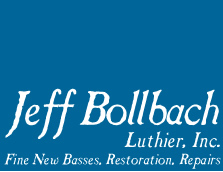|
|
|
|
|
|
LUTHIER
RANT
Fingerboards
| Bass Bars | Glues | Saddles
| Bridges
My Tuners | The
Sound Post | Regraduation
|
BASS BARS [continued] Here's another example of how the spring translates to the end of the bar. Restoration was being undertaken on a "Testore" owned by a famous pedagogue. The top was slab-cut and there was extensive worm damage to the upper region of the plate [where the upper end of the bar would be]. This was dealt with by flooding it with cyanoacrylate glue and dust. Then the bar was fit with enough spring that only an extremely strong man could pull the plate to the bar. I tried and failed [I am just shy of six foot and 185 lbs.] The bass went out and it was lent to one of the pedagogue's students. One day the student calls up and says he took it out of the case and there was a hole in the top. The bass is brought in and sure enough there's a hole you could stick two fingers in just at the upper end of the bar. It is stated that the bass must have been hit, which the kid denies. The kid is made to look like a liar after the bass was lent to him in good faith. When the top was removed, all the spring had translated to the end of the bar and it was pulled well over an inch away from the plate with a half dollar sized piece of the top still glued to it. The wood was pretty much particleboard after the dust and stupid glue- there was no grain strength. There also was no dent on the piece and if you look at a bass in this area-it's extremely protected. You'd have to go in there with something pointed to get at it. Of course, the repair of the damage was probably a huge amount of money proving once again that while crime may not pay unbelievably shabby lutherie does. Before I forget, I wanted to address the issue of sinkage at the lower end of a bassbar with an integrally carved bar. It kind of makes sense that a bar that has lost its spring could cause a general overall sinking of the top. But to think that this causes a top that is sinking right at the lower end of the bar really doesn't make sense. Except that very often basses with integrally carved bars are sunk right in that spot. By definition an integrally carved bar cannot have spring therefore the sinkage must have been caused by lack of spring. If you look, deeper though, there's another answer. First of all these are almost always crudely made instruments. The integral bar was done mostly for speed of production and economy of wood. The blocks were usually small and inaccurate, leading to structural problems. Further, these basses were very likely poorly cared for. Most importantly, when you see one of these basses with this symptom there will always be one or more cracks leading to or along the bar. A crack in this locale will cause it to lose its structure and sink. In conclusion, a sound structure is integral to an instrument's health and longevity. This is accomplished by attention to detail - making sure that every aspect of construction is as accurate and true as possible. Assembly should be relaxed - ALL joints must fit. This sounds elementary but many joinings on the bass can take a great deal of time to make them true. Many are not willing to take that time. Tension does not need to be built in - plenty will come. Remember the egg. P.S. I showed this to my friend and steamed colleague, Arnold Schnitzer and he was in agreement with it. That boy knows how to get a good sound - after all, he's got most of the top players in the metro area sewed up. But, what a wit as well. When discussing the concept of an instrument needing tension in the bar to counter act the force of the bridge, Arnold came up with the idea that the soundpost needs tension to help support the pressure on the treble side. Many basses can be seen to sink on this side as well [just to clarify - THIS IS A JOKE]. Now, you really can't put enough tension in the post while setting it in the conventional manner so you would need to build into the post a way to push up on the top. I thought it should work like a jack for a car and right away came up with the name "PostJack." We were gonna put it up on the net as a troll. Well, it was funny at the time. |


| 359 Miller Avenue, Freeport, NY 11520 (516) 867 1395 · jbollbach17@gmail.com |